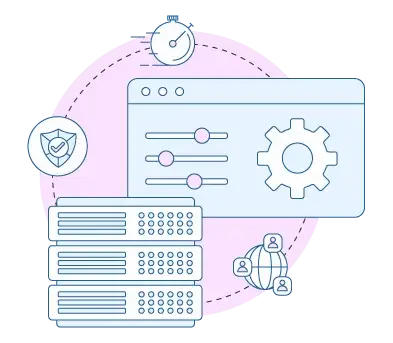What is Plesk?
If you’ve dipped your toes into website building before, you already know how important it is to find a user-friendly environment for managing your projects. There are more than a few areas to keep an eye on – domain names, emails, files, databases, backups. If you don’t have an intuitive platform to handle them all – you can easily get overwhelmed.
Luckily, all the best hosting providers have got you covered.
When we talk about control panels in web hosting, the average client would probably pinpoint cPanel as the most popular solution. The platform is easy to use, packs a ton of features and allows for effortless website management.
But looking at the global market (at least websites with reported control panels), it turns out there is another sheriff in town – Plesk.
What is Plesk?
Plesk is an all-in-one hosting management solution that allows server administrators to easily manage all aspects of their online projects. The platform was first released in 2001 by the developers from Plesk International GmbH. Plesk has seen its fair share of different owners through the years.
The control panel solution was first sold to SWSoft in 2008, and after several rebrands, pivoted itself into a separate entity in 2015. Two years later, British Oakley Capital Limited acquired the rights to Plesk for around $105 million. Incidentally, the same company owns a bunch of complementary and even rival products – cPanel, WHMCS, SolusVM, and more.
The Plesk control panel includes numerous useful extensions covering data backups, emails, DNS tools, security widgets, and other essential functionalities.
But perhaps the biggest selling point for VPS and dedicated server owners is versatility. Plesk is one of the few prominent hosting management platforms that support both Linux and Windows users.
Plesk Benefits
Time to dig deeper and see why Plesk excels so much and what keeps it a top preference for VPS web hosting clients.
Looking at its product characteristics, a few reasons quickly catch the eye:
- Extended OS Support – easily standing out from many market competitors, Plesk integrates with both Linux and Windows OS versions. It doesn’t matter if you want to run WordPress/Joomla or a .NET framework project, a MySQL or MSSQL database solution – Plesk supports it all.
- Effortless to Manage – you don’t have to be a programming genius or deal with endless lines of code. Plesk simplifies your hosting management with drag-and-drop navigation and one-click functionalities. This way, even a complete newbie can turn into a server administrator in no time.
- Great WordPress Automation – WP lovers have it easy when it comes to managing the CMS via Plesk. The control panel flaunts built-in support for Git, Docker, WP Toolkit, and many more automation features.
- Mobile-friendly App – as smartphone and tablet usage is on a constant rise, operating the hosting server through a phone is an option no provider should overlook. Plesk duly delivers in that area, offering a mobile-friendly app, which helps the control panel look great on all devices.
Plesk Main Features
Plesk relies on a user-friendly interface, one that looks pretty similar to what cPanel has to offer. You can find all menus and submenus on the left, with essential information and server statistics right in front of you. The platform is feature-rich right off the bat, but some of the functionalities deserve special attention:
- Domains – helps you manage domains, add parked and subdomains, configure domain aliases, and many more. The go-to place when you need to redirect domains or set up different records (A, CNAME, MX).
- Mail – creating email accounts with your branded domain name is one of the perks of having one in the first place. Plesk helps you create/edit/delete mailboxes, set up resource quotas, configure spam filters, and a ton more.
- File Manager – this is the best alternative if you don’t want to deal with FTP services for managing your site files. Contains a variety of options for import/export, directory creation, and file migration.
- Security – Plesk comes with neat firewall customization options. Full support for Let’s Encrypt and their SSL solutions allows for free security certification. Includes an AI-powered antivirus and malware monitoring tool.
- Application – the section that contains all your software installations and the options to manage them. You can also benefit from a list of selected Featured CMS Applications or simply access all available app choices.
On top of it all, Plesk also offers valuable statistics and analytics that help you see the bigger picture around your online project. Which are your most popular pages? Where are your visitors coming from? What are your most successful traffic channels? Plesk has a report for everything!
Plesk Pricing
As a proprietary product, Plesk does not offer a free account option, but you can still save some money if you’re willing to commit long-term. Going for a yearly subscription, you get the control panel with a free month and three additional months at half price.
Plesk separates its services into two categories – for VPS users and dedicated server clients. Each contains three packages and a custom deal option.
- Web Admin (VPS) – from $10/month, paid yearly;
- Web Pro (VPS) – from $15.10/month, paid yearly;
- Web Host (VPS) – from $25.20/month, paid yearly;
- Web Admin (Dedicated) – from $10/month, paid yearly;
- Web Pro (Dedicated) – from $15.10/month, paid yearly;
- Web Host (Dedicated) – from $45.40/month, paid yearly;
The plans mainly differ in the number of domains they can handle and the features included. The only price difference for VPS and dedicated server users is at the Web Host tier, allowing you to manage unlimited domain names and benefit from Plesk’s full set of options.
Plesk Alternatives
Plesk might not have many viable alternatives when it comes to Windows server management, but Linux users can easily find something well-suited if this control panel is not their cup of tea. Some of the noteworthy names include:
- cPanel – Plesk’s closest competitor. Both platforms rely on an intuitive interface and easy user management. Few other solutions can compare to cPanel when it comes to features, though, and the platform continues to evolve actively. Great one-click software autoinstaller. Supports Linux servers only.
- SPanel – а relatively new hosting management platform, developed by ScalaHosting. This versatile control panel takes the best out of cPanel but delivers it absolutely free of charge for Scala users. Includes other proprietary modules for security (SShield) and WP automation (SWordPress Manager).
- Webmin – is a web-based tool that helps you efficiently operate any Unix-based server machine. Recent versions have included Windows support as well. Compatible with all major browsers. You can expand the control panel functionalities via modules. Free for use under a BSD license.


Conclusion
Powering over 350,000 servers and 11 million websites, Plesk is a solid control panel with a rich feature set. Well-suited for Linux and Win-based projects, the platform is quite intuitive and doesn’t take a lot of time to master.
But will Plesk continue to dominate the market, or will new solutions emerge?



